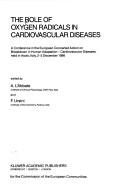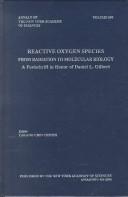| Listing 1 - 10 of 96 | << page >> |
Sort by
|
Multi
ISBN: 9780128224960 0128224967 0128224819 9780128224816 Year: 2020 Publisher: London, England : Academic Press,
Abstract | Keywords | Export | Availability | Bookmark
 Loading...
Loading...Choose an application
- Reference Manager
- EndNote
- RefWorks (Direct export to RefWorks)
"Covers the ecotoxicology of environmental heavy metal ions and the interactions between specific heavy metals-induced cell responses and oxidative stress Provides a better understanding of the mechanism of nanomaterial-induced toxicity as a first defense for hazard prevention Covers recent advances in new nanomedication technologies for the effects of NPs on oxidative stress, ROS and ER stress Discusses the effects of interactions between antioxidant defense therapy, ROS and strategies for treatment"--
Book
Year: 1994 Publisher: San Diego New York Boston : Academic press,
Abstract | Keywords | Export | Availability | Bookmark
 Loading...
Loading...Choose an application
- Reference Manager
- EndNote
- RefWorks (Direct export to RefWorks)
Book
ISBN: 1578086868 9781578086863 Year: 2010 Publisher: Enfield: Science publishers,
Abstract | Keywords | Export | Availability | Bookmark
 Loading...
Loading...Choose an application
- Reference Manager
- EndNote
- RefWorks (Direct export to RefWorks)
Antioxidants --- Active oxygen --- Plants
Book
ISBN: 161209466X 9781612094663 9781611225020 1611225027 Year: 2011 Publisher: Hauppauge, NY : Nova Science Publishers,
Abstract | Keywords | Export | Availability | Bookmark
 Loading...
Loading...Choose an application
- Reference Manager
- EndNote
- RefWorks (Direct export to RefWorks)

ISBN: 0898384079 Year: 1988
Abstract | Keywords | Export | Availability | Bookmark
 Loading...
Loading...Choose an application
- Reference Manager
- EndNote
- RefWorks (Direct export to RefWorks)
Book
Year: 2019 Publisher: Paris : OECD Publishing,
Abstract | Keywords | Export | Availability | Bookmark
 Loading...
Loading...Choose an application
- Reference Manager
- EndNote
- RefWorks (Direct export to RefWorks)
Phototoxicity is defined as a toxic response is elicited by topically or systemically administered photoreactive chemicals after the exposure of the body to environmental light. Several classes of photoreactive chemicals could cause phototoxic reactions when activated by light at otherwise non-toxic doses. Phototoxicity can be categorized as photoirritation, photoallergy, and photogenotoxicity. The purpose of this test is to measure the phototoxicity of a chemical. The main event in any phototoxic reaction is the absorption of photons of a wavelength that induces the excitation of the chromophore. Excitation energy is often transferred to oxygen molecules, followed by the generation of ROS (reactive Oxygen Species). Measurements are performed using a spectrometer. The determination of the ROS generation from irradiated chemicals with simulated sunlight is indicative of phototoxic potential.
Book
Year: 2007 Publisher: Beltsville, Md. : U.S. Dept. of Agriculture, Agricultural Research Service, Beltsville Human Nutrition Research Center, Nutrient Data Laboratory,
Abstract | Keywords | Export | Availability | Bookmark
 Loading...
Loading...Choose an application
- Reference Manager
- EndNote
- RefWorks (Direct export to RefWorks)
Book
Year: 2019 Publisher: Paris : OECD Publishing,
Abstract | Keywords | Export | Availability | Bookmark
 Loading...
Loading...Choose an application
- Reference Manager
- EndNote
- RefWorks (Direct export to RefWorks)
Phototoxicity is defined as a toxic response is elicited by topically or systemically administered photoreactive chemicals after the exposure of the body to environmental light. Several classes of photoreactive chemicals could cause phototoxic reactions when activated by light at otherwise non-toxic doses. Phototoxicity can be categorized as photoirritation, photoallergy, and photogenotoxicity. The purpose of this test is to measure the phototoxicity of a chemical. The main event in any phototoxic reaction is the absorption of photons of a wavelength that induces the excitation of the chromophore. Excitation energy is often transferred to oxygen molecules, followed by the generation of ROS (reactive Oxygen Species). Measurements are performed using a spectrometer. The determination of the ROS generation from irradiated chemicals with simulated sunlight is indicative of phototoxic potential.
Book
Year: 2019 Publisher: Paris : OECD Publishing,
Abstract | Keywords | Export | Availability | Bookmark
 Loading...
Loading...Choose an application
- Reference Manager
- EndNote
- RefWorks (Direct export to RefWorks)
Phototoxicity is defined as a toxic response is elicited by topically or systemically administered photoreactive chemicals after the exposure of the body to environmental light. Several classes of photoreactive chemicals could cause phototoxic reactions when activated by light at otherwise non-toxic doses. Phototoxicity can be categorized as photoirritation, photoallergy, and photogenotoxicity. The purpose of this test is to measure the phototoxicity of a chemical. The main event in any phototoxic reaction is the absorption of photons of a wavelength that induces the excitation of the chromophore. Excitation energy is often transferred to oxygen molecules, followed by the generation of ROS (reactive Oxygen Species). Measurements are performed using a spectrometer. The determination of the ROS generation from irradiated chemicals with simulated sunlight is indicative of phototoxic potential.

ISBN: 157331238X 1573312398 9781573312394 9781573312387 Year: 2000 Volume: 899 Publisher: New York (N.Y.) : New York academy of sciences,
Abstract | Keywords | Export | Availability | Bookmark
 Loading...
Loading...Choose an application
- Reference Manager
- EndNote
- RefWorks (Direct export to RefWorks)
| Listing 1 - 10 of 96 | << page >> |
Sort by
|

 Search
Search Feedback
Feedback About UniCat
About UniCat  Help
Help News
News